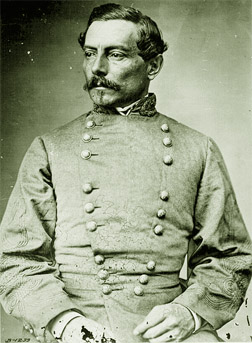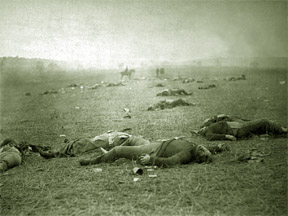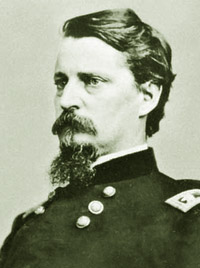By Tomas Mc Rae,
Brisbane, Queensland, Australia, ©2009
[This
article is featured in the Lowlands-L Gallery presentation.]
 ike some Scottish Highlanders after the Jacobite Rebellions, bitterness still
exists among many in America’s Southern States although years have passed
since this awful conflict ended. Many still describe it as either “The War
Between the States” or even “The War of Northern Aggression”. Me? I remain
neutral.
ike some Scottish Highlanders after the Jacobite Rebellions, bitterness still
exists among many in America’s Southern States although years have passed
since this awful conflict ended. Many still describe it as either “The War
Between the States” or even “The War of Northern Aggression”. Me? I remain
neutral.
How
did it all start? Standard answer is “Slavery” and that certainly was a factor
but far from the only one. Differences in economies and ways of life also
helped trigger the conflict.
The
Southern States had an economy largely based on exporting cotton which required
intensive labour to grow, harvest, and process. Income was excellent but
it’s never a good idea to focus on a single crop. Keep in mind that four
of the States supporting the Union in the conflict remained slave states,
vide Missouri, Delaware, Maryland, and Kentucky.
In
the North industry flourished along with a diversified agriculture and massive
inputs of European immigrants to keep it all going. Slavery had gradually
been eliminated in the North and the United States was composed of equal
numbers of free and slave states.
The
Americans won the Mexican-American War and gained huge areas of land that
had belonged to Mexico. New settlers moved into those territories from both
North and South and tension grew out of this. Cotton takes a lot out of the
soil and in those pre-chemical-fertiliser days growers needed new land for
its cultivation. This also meant importing slaves and there was great opposition
in the North to such moves, Compromises were made, then abolished and factional
conflict broke out in some new States. Democratic President Buchanan was
elected in 1856 and did little or nothing to ease the tensions.
Mention
must be made here of John Brown who in that same year led a mob of thugs,
including his sons, to hack six unarmed Pro-Slavers to death with sabres,
slavery being still legal. Two of the victims were teenage boys. For this
act of wanton savagery he was, and still is, regarded as a hero in the North
and got off Scot-free.
He
continued his ravages until wounded and captured during an abortive raid
on the government armoury at Harper’s Ferry. The military forces overcoming
Brown were led by a Colonel Robert E. Lee: a Lieutenant J.E.B. Stewart tried
to negotiate with the insurgents. Neither was a Freemason; both will appear
prominently later in my tale. Brown’s execution led to waves of protest in
the North where he became a martyr. His victims are largely forgotten.
A
new political party emerged as disillusionment with the old Whigs and the
Democrats grew in the North. Out of this the new Republican Party emerged
in time for the 1860 elections when its candidate Abraham Lincoln was elected
president. It now seemed that the North would dominate Senate and Congress
and the stage was set for the conflict.
North
Carolina seceded from the Union in the last month of 1860 and during the
early months of the following year several other states joined them. The
biggest shock for the Union was the secession of The Commonwealth of Virginia
which had played an important role in establishing the United States of America.
The secessionist states formed the confederate states with its capital at
Richmond, Virginia.
 General
Pierre Gustave Toutant Beauregard (1818–1893)
General
Pierre Gustave Toutant Beauregard (1818–1893) |
Tensions
grew. Then North Carolina demanded that Union forces quit forts on islands on offshore territory. The Union stood firm and a Confederate Freemason, General Pierre Beauregard, triggered the war by shelling Fort Sumner. The sole casualty was a mule and Union forces were permitted to evacuate in good order. It would not be all that long before it was more than mules that made bloody ends over the next four years.
I
have no intention of going into this tragedy in detail. My aim here is to recount some events involving Freemasons on both sides. The Confederacy was dependent of cotton exports to finance the war but it lacked any significant navy, so the Union warships blockaded the Southern ports. Cotton could not be exported and essential imports were blocked. Things came to a head on the Mississippi river when New Orleans was captured by Admiral, and Brother, Farragut.
One
amusing incident involves the Admiral and a commander of one of his small gunboats, a Lt, and Brother, Schly, who was sent on a reconnaissance mission, but when Farragut heard gunfire up ahead he flag-signalled Schly to withdraw.
Contrary
to orders the lieutenant kept shelling targets. He ended up summoned to the
foredeck of Farragut’s ship where an angry admiral castigated him so harshly
he felt he may well hang from the yardarm. As it was he received a severe
reprimand from a stern faced admiral.
The
admiral then told the culprit to join him in his cabin as he had more to
say. On entering, shaking at the knees Schly was handed a glass of sherry
by his boss who then said, “Young man, if I was in command of a gunboat and
was getting the better of an enemy I’d have turned a blind eye as well.”
 The harvest
of death, Gettysburg
The harvest
of death, Gettysburg
(Photograph by Timothy H. O’Sullivan,
July 1863) |
Later
in the war, when marching to Gettysburg, a Union Lt, Brother Brown took pity on his men who were desperate for water. He grabbed several canteens and filled them at a well. For this act of disobedience he was arrested and imprisoned. General, Brother, Stannard, learning of this ordered the soldier’s immediate release and return to his regiment. His sword had been placed on a wagon well to the rear so, in the midst
of the bloody final third day at Gettysburg, he used an axe with great effect then confiscated a sword from a Confederate officer he had captured.
The
battles around Gettysburg over three days in early July 1863 merit some mention.
It all started virtually by accident. Robert E. Lee had crossed the Potomac
River into Maryland, he thought his opponent was the incompetent Gen Hooker,
but he soon discovered he had just been replaced by General Meade whose army
was somewhere ahead.
He
sent General Stewart and his cavalry to scout around and locate the enemy;
Stewart’s men having proved themselves as his eyes and ears many times before.
Stewart’s orders were vague and he lost contact with main force. His cavalry
wandered around finding only small Union forces and capturing a string of
wagons of horse fodder.
In
the meantime Lee was travelling blind but moving towards the major crossroads
at a small Pennsylvanian market town called “Gettysburg”. Confederate General,
and Brother, Henry Heth was in advance and hoped to find a supply of shoes
in the town for many of his men who were barefoot. On a ridge to one side
of the town, Seminary Ridge, he made contact with advance parties of Union
forces on July 1st, and it was on! Throughout the day forces from both sides
converged on the town and by nightfall the Confederates had captured the
place and adjacent Seminary Ridge.
 General
Winfield Scott Hancock (1824–1886)
General
Winfield Scott Hancock (1824–1886) |
On
the other side of the town was Cemetery Ridge where General, Brother, Hancock
concentrated his men along its length in an effective fishhook shape. To
its left, near the town Confederate forces occupied some of the lower slopes.
To its right rose two steep hills: Little Round Top and Big Round Top.
On
day two of the conflict Lee ordered an attack on the Round Tops and lower
adjacent areas. Colonel, and Brother, Joseph Chamberlain was ordered to place
his small force on Little Round Top and informed that the line ended there.
Hold at all costs or Lee’s men could occupy it and infiltrate the entire
ridge.
On
the ground below the hills several violent conflicts broke out and in a cluster of huge boulders known as The Devil’s Den many bullet pocks are still present on the rocks.
A strong Confederate force attacked Chamberlain’s smaller group only to be driven off. There were several more attempts
during one of which Chamberlain’s metal sword scabbard was hit by a rifle ball bruising him badly. Despite
this he kept his men together and fought on against hopeless odds. Ammunition
was running out, so the men collected what they could from dead and wounded
comrades.
Finally,
as his ammunition was nearly gone, he ordered his force to fix bayonets and
they drove the Confederates off the Round Top for good. Just three years
before Brother Chamberlain had been a Professor of Theology at a College
in Maine. He went on to be wounded three times, was raised to rank of general,
and was present at the final surrender.
That
evening Stewart and his men put in a belated appearance. His cavalry had
consumed all the horse fodder and achieved zilch.
Day
three and Lee ordered General Longstreet to launch a massed frontal charge
on a small clump of trees towards the centre of Cemetery Ridge. Commanding
the centre of the attacking force was General, Brother, George Picket supported
by General Brothers Kemper and Armistead. Armistead’s best friend had been
General, Brother, Hancock up on the Ridge with his Union forces. Armistead
had even been best man at his wedding. Longstreet did all he could to dissuade
Lee from this risky attack, but the old warhorse’s will prevailed.
The
charge began with a massive artillery bombardment from the Confederate side
launching loads of steel at the defenders.
In
the midst of the chaos of noise and smoke the Confederate gunners did not
realise that their cannon trunnions were digging ever deeper into the soil
after each recoil causing many guns to elevate throwing their loads over
rather than on the ridge. Union cannoneers responded and the area was masked
in smoke. Eventually the defending gunners ceased firing to let their weapons
cool which may have led Longstreet’s men to believe they had been knocked
out.
Whatever
the reason, the massive Confederate army moved off in drill order with bands
playing towards the distant ridge. Once within cannonball range gaps started
to appear in the attacker’s ranks and parade ground formations broke up.
On passing close to Little Round Top entrenched cannon and rifle fire caused
formations on the right to compress, breaking ranks, then the canister shot
began to hit and soon the Confederate force was within range of concentrated
Union rifle fire.
Up
on the Ridge General Hancock maintained the morale of his men by riding unconcernedly
through shellfire. A chunk of shrapnel hit his horse’s saddle dislodging
a nail which entered the General’s thigh. Despite this he refused to leave
the field until things were resolved.
The
charging army became a bloody debacle as the men heroically tried to reach
the top of the Ridge. General Armistead had stuck his hat on his sword as
he led his men ever closer to the summit. A Union cannon discharged near
him and he placed a hand on it announcing its capture but he was then hit
by a rifle ball. As he fell he allegedly cried, “I am a widow’s son”. Captured
he asked to meet Hancock who had been wounded about the same time. Hancock
sent an aide to Armistead who realised he was mortally wounded. He asked
the aide to pass on personal effects to Hancock to send to his family when
possible and died that night. Lee’s forces quit the field under cover of
darkness. It was July 4th.
Next
day Meade received news that the key Confederate City and port of Vicksburg
had been captured by General Grant. At the surrender of Vicksburg Freemasons
on both sides met in harmony and Union officers entertained their erstwhile
enemies with food and wines.
Lee’s
men managed to recross the Potomac and the slaughter continued for two more
years.
The
year after Gettysburg and Vicksburg an attempt to break the US naval blockade
ended partially in triumph but mainly in tragedy. Prior to this it was decided
to try breaking the blockade of Charleston North Carolina using a submersible
craft. A large discarded boiler was the basis of this boat which had a stern
and prow fitted along with a long conning tower. This was propelled via power
from a large hand crank operated by several men in a dim confined space.
H.L.
Hunley envisaged the idea and died when trialling the vessel along with its
first crew. It was then raised, refitted, and transported by rail to Charleston
where General, Brother, Beauregard was instrumental in maintaining the project.
A long spar running from the bow had an explosive charge at its extremity.
One
night in February 1864 this boat actually sank a US navy warship, the Housatonic.
Then it vanished until re-located in the 1980s. The massive explosion seems
to have sprung the Hunley’s plates and it was swamped and sank. It was eventually
raised and clearing the inside begun. On the remains of its commander, Lt
Dixon, a pocket watch was found with a fob bearing the Square and Compasses.
There
were numerous other incidents involving Brethren of both sides supporting
each others’ adversities. Masonic funerals were held for fallen men on enemy
territories with Union and Confederate Brethren in attendance.
Finally
I must mention a Wallace who distinguished himself during and after the war.
General, and Brother, Lew Wallace saved Washington, DC, when Lee sent General
Jubal Early and General, Brother, Breckinridge to attack and try and occupy
the capital of the Union. Wallace rallied forces which delayed the Confederate
march on the city allowing reinforcements to move up and stall this military
gamble.
You
may not have heard of Lew Wallace, but I’ll bet you know of one of his books: Ben Hur. Prior to this he served as military judge at the trials of the Lincoln Assassins
and at the trial of Henry Wirtz, commandant of the notorious Confederate
POW camp at Andersonville.
He
went on to be appointed Lt Governor of the territory of New Mexico where
he met and negotiated with Billy the Kid regarding a pardon the latter did
not receive. A year later he became US minister to the Ottoman Empire.
Prince
Albert Lodge also meets in this Centre. He was the much-loved husband of
Queen Victoria and exercised some progressive moves for the betterment of
the common people. I have been unable to discover if he was a Freemason.
He was however instrumental in steps to ease a dangerous situation between
Britain and the Union in 1861.
A
party of Confederate delegates boarded a British ship to sail to Europe and
plead the case for the South. A Union warship in British Caribbean waters
boarded this ship illegally and arrested the Delegation. There was great
anger at what was an act of blatant piracy in Britain and the Cabinet drafted
a very strong letter to the Union and sent troops en route to Canada.
The
Prime Minister showed the letter to Albert who realised that not only could
it lead, in its present form, to Britain invading Union territory but also
stimulate other European states to take sides and start a world war. Although
already seriously ill, Albert requested to be allowed to redraft the letter
in less threatening terms and the arrested men were released. He died soon
afterwards

